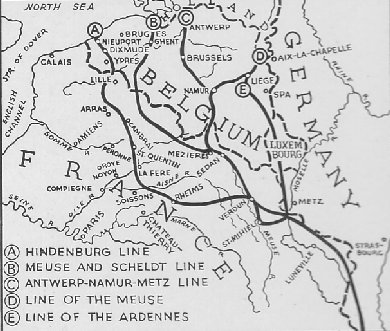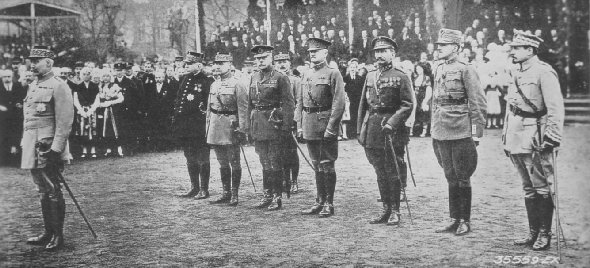
Click to enlarge.
When this order came with all of its suddenness, the men, not knowing what it was all about, were stunned. On learning that the war was over, the scene became indescribable—nerves snapped—men lost their reason, many never to recover. As the guns stilled, the pitiful cries of the wounded filled the air. The dead and the mangled lay in heaps. Officers had difficulty in stopping the carnage. There was no demonstration at the front—unless men collapsing and wallowing in the blood-soaked mud, could be called a demonstration. The following day, November 12, newspaper men, learning of the wild demonstration in all of the Allied countries, induced the boys to pose for pictures to show "the folks back home."
 Click to enlarge. |
GERMANY'S LINES OF DEFENSE
Knowing that the Germans had three other strong lines of defense in allied territory, President Wilson viewed with suspicion Germany's note of October 5, requesting him to take steps toward an armistice. Notwithstanding the fact that the Hindenburg Line had been smashed in September, the Allied High Command thought that Germany could not be conquered before 1919. Each government transmitted four notes before the President took Germany's request seriously and advised them, November 5, that they might ask Marshal Foch for an armistice. |
The celebrating was done by the folks back home. And not all of the folks at home participated. There were no Gold Star mothers out making merry. The final casualty lists had not been published and millions of mothers and fathers sat silently at home, hoping and praying. Those who had lost sons, brothers, fathers, or intimate friends in the war, stood around in little silent groups watching the tumult. They were not able to realize that it was all over. But they were aware of the fact that it did not now matter so much to them. For them the Armistice had come too late. It was they who were not personally touched by the war, who put on the show.
The story so often told and screened about the Germans and Americans getting right together, shaking hands and becoming pals, is unadulterated fiction. Individuals are not prone to forget even petty quarrels instantly. The fury of hatred was at its height when the order "Cease firing!" went down the lines.
That hatred could not immediately abate. A helmet appearing over the opposite trench meant a whistling bullet, if an officer were not standing by. The German soldier never quit. He was fighting just as viciously as ever, at the last moment. The "quitting" was by his folks back home, and by his Kaiser. The Armistice was as much of a surprise to the German in the line, as to the American.
Just why the war was continued six additional hours, instead of becoming effective instantly at 5 A.M. when the Armistice was signed, is known only to the powers who sat in the car in the Woods of Compiegne that night. By eleven o'clock, some outfits had advanced as far as to be out of contact with headquarters. Just when the news reached them, the official record sayeth not. The slaughter on the morning of November 11 was appalling. The battle raged all along the line with unabating fury until eleven, on the dot. It is not strange that the officers experienced great difficulty in enforcing the order "Cease firing!"
 |
| Ceremony attending the induction of General Petain as Marshal of France. Metz, Dec. 18, 1918. (Front) Marshal Petain, Commander-in-Chief of the French Armies. (Left to Right) Marshal Joffre, First French Commander-in-Chief and hero of the Marne; Marshal Foch, Commander-in-Chief of the Allied Forces; Field Marshal Haig, Commander-in-Chief, British Expeditionary Forces; General Pershing, Commander-in-Chief, American Expeditionary Forces; General Gillain, Belgian Army Commander; General Albricci, Commander, Italian 2nd Corps; General Haller, Commander of the Polish Legion in France. (Rear) General Weygand, Chief of Marsahl Foch's Staff. |